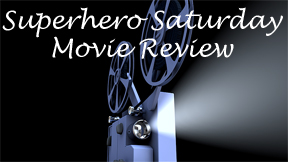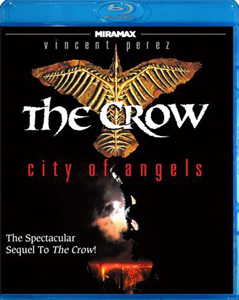“The Crow” saga moves the action from Detroit to Los Angeles for its first sequel, “City of Angels” (1996), and I expected a slicker entry in a thriving metropolis with a love story and a Goo Goo Dolls song. But I was mixing this up with 1998’s romance movie “City of Angels,” from which the ubiquitous GGD song “Iris” comes.
As it turns out, “The Crow’s” gritty Los Angeles looks the same as its Detroit; the whole saga takes place in an alternate near-dystopian reality.
Same ole story
Ubiquitous superhero scribe David S. Goyer tells the same story as the cult-classic 1994 original. A new guy, Vincent Perez’s Ashe, is resurrected as the crow-guided, face-painted Goth superhero. The targets of his revenge are drug dealers – with Richard Brooks’ Judah atop the food chain — who murdered him and his son when they stumbled across a gangland murder.

“The Crow: City of Angels” (1996)
Director: Tim Pope
Writer: David S. Goyer
Stars: Vincent Perez, Mia Kirshner, Richard Brooks
To be honest, I enjoyed spending time in the world of “The Crow” again. Director Tim Pope, production designer Alex McDowell and cinematographer Jean-Yves Escoffier construct a lived-in world of rundown buildings, crumbling infrastructure, and perpetual fog from above and steam from below.
The film’s preoccupation with its style side extends to the casting. Mia Kirshner (“24”) plays Sarah, the now-young-adult street urchin from the first movie who has visions of The Crow’s torment. Sarah has no plot purpose other than to eventually be kidnapped, and Kirshner has nothing to do in terms of playing out a character arc, yet she is mesmerizing.
With her ivory skin and big eyes and emotional pain, she captures a certain late-’90s aesthetic. She’s like a more Goth version of Natalie Imbruglia’s music-video persona — someone who is emotionally torn up and lying broken on the floor.
The soundtrack adds a lot to the vibe. While there’s no Goo Goo Dolls (and rightly so), there is Deftones (who make an in-film appearance), Filter, Bush, Toadies, PJ Harvey, etc. – the sounds of 1996 youths caught up in their first experiences of heartbreak and cynicism about the world. No movie will ever again have a soundtrack like this, so let’s stop and appreciate it for a moment.
Cast has some flavor
Perez is also cast for his looks, no doubt, and in that sense he’s fine. His French accent distinguishes him from Brandon Lee’s original Crow. But I hoped for more out of Brooks, who was so good in “Law & Order” and later in an episode of “Firefly.”
Judah is a generic drug lord, and he’d actually be rather bumbling if not for his advisor who is a seer. Sybil (Tracey Ellis) always has her hood pulled down, and the hood is shaped like a perching crow, which is neat.

Judah’s henchmen – played by Thomas Jane, Iggy Pop and Thuy Trang — bring a little bit of flavor. The showdown between The Crow and Iggy Pop’s Curve in an urban tunnel is nicely done. (The other fight scenes are bad, using so many close-ups that a viewer can’t get a sense of the dynamics.) I like how The Crow’s dumping of Curve’s body into a river of industrial waste is accompanied by quiet onlookers in masks.
The sequel peppers Day of the Dead parade festivities into the background, and it becomes more explicit – and surreal – when the final showdown takes place amid the masked revelers. I’m not sure if it makes sense that they’d be cheering when people are trying to kill each other; maybe they think it’s part of the show?
There’s no storytelling originality in “City of Angels,” so you’re in for an empty viewing experience if you want something new and unexpected. But if you like the aesthetics of Goth superhero-ing and 1996 teen angst, “The Crow: City of Angels” is an oddly comforting time capsule to dive into.

